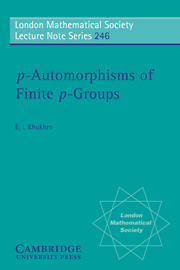Book contents
- Frontmatter
- Contents
- Preface
- Introduction
- Chapter 1 Preliminaries
- Chapter 2 Automorphisms and their fixed points
- Chapter 3 Nilpotent and soluble groups
- Chapter 4 Finite p-groups
- Chapter 5 Lie rings
- Chapter 6 Associated Lie rings
- Chapter 7 Regular automorphisms of Lie rings
- Chapter 8 Almost regular automorphism of order p: almost nilpotency of p-bounded class
- Chapter 9 The Baker–Hausdorff Formula and nilpotent ℚ-powered groups
- Chapter 10 The correspondences of A. I. Mal'cev and M. Lazard
- Chapter 11 Powerful p-groups
- Chapter 12 Almost regular automorphism of order pn: almost solubility of pn-bounded derived length
- Chapter 13 p-Automorphisms with p fixed points
- Chapter 14 Automorphism of order p with pm fixed points: almost nilpotency of m-bounded class
- Bibliography
- Index of names
- Subject Index
- List of symbols
Chapter 11 - Powerful p-groups
Published online by Cambridge University Press: 22 October 2009
- Frontmatter
- Contents
- Preface
- Introduction
- Chapter 1 Preliminaries
- Chapter 2 Automorphisms and their fixed points
- Chapter 3 Nilpotent and soluble groups
- Chapter 4 Finite p-groups
- Chapter 5 Lie rings
- Chapter 6 Associated Lie rings
- Chapter 7 Regular automorphisms of Lie rings
- Chapter 8 Almost regular automorphism of order p: almost nilpotency of p-bounded class
- Chapter 9 The Baker–Hausdorff Formula and nilpotent ℚ-powered groups
- Chapter 10 The correspondences of A. I. Mal'cev and M. Lazard
- Chapter 11 Powerful p-groups
- Chapter 12 Almost regular automorphism of order pn: almost solubility of pn-bounded derived length
- Chapter 13 p-Automorphisms with p fixed points
- Chapter 14 Automorphism of order p with pm fixed points: almost nilpotency of m-bounded class
- Bibliography
- Index of names
- Subject Index
- List of symbols
Summary
The theory of powerful p-groups was created by A. Lubotzky and A. Mann [1987]; it was also anticipated in an earlier work of M. Lazard [1965]. Powerful p-groups have already found several applications in the theories of finite p-groups, of pro-p-groups, of residually finite groups, of groups with bounded ranks, of groups of given coclass, etc. One can say that the theory of powerful p-groups reflects the properties of the “linear part” of a finite p-group of given rank. Applications to finite p-groups with almost regular p-automorphisms are based on the bounds for the ranks in terms of the number of fixed points and the order of the automorphism (§2.2). The exposition in this chapter follows [A. Lubotzky and A. Mann, 1987] and includes some lemmas from [A. Shalev, 1993a] and [J. D. Dixon et al., 1991]. The proofs, however, are here inflated to a more verbose form, to make them accessible for a beginner; some sharper bounds are sacrificed for the same reasons. We shall consider only the case when p is an odd prime; the same results hold for p = 2, but the definitions and some proofs are a little different (although not more difficult) and are left as exercises to the reader.
Definitions and basic properties
Throughout the chapter, p denotes a fixed prime number, which is assumed odd, if not otherwise stated.
- Type
- Chapter
- Information
- p-Automorphisms of Finite p-Groups , pp. 130 - 139Publisher: Cambridge University PressPrint publication year: 1998

